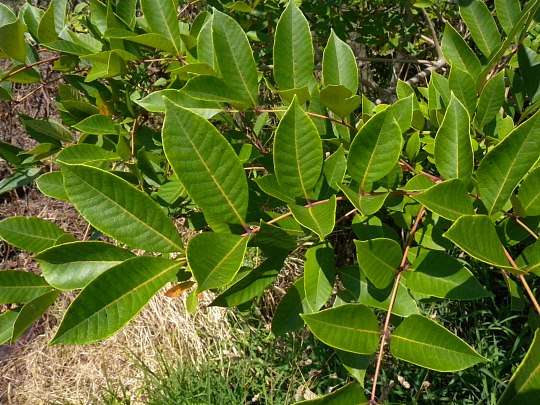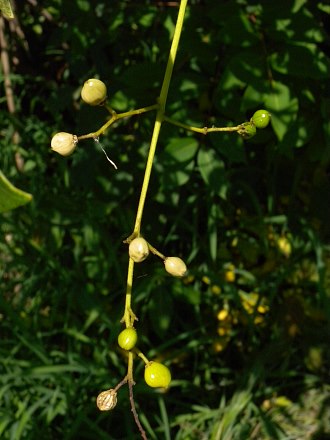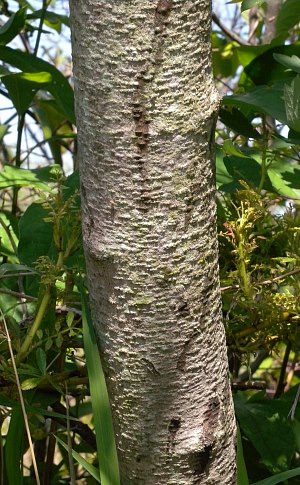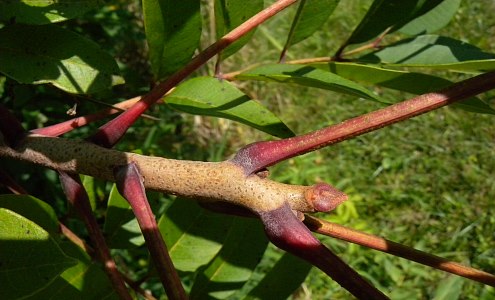
Because Poison Sumac is usually dioecious, the same shrub produces either all male (staminate) or all female (pistillate) flowers. Less often, both male and female flowers are produced on the same shrub, while other shrubs produce perfect flowers. The flowers are produce in panicles from the axils of the compound leaves; individual panicles are up to 8" long and 4" across. The peduncles and petioles of these panicles are glabrous or finely pubescent. Individual flowers are about 1/8" (3 mm.) across, consisting of a short green calyx with 5 teeth and 5 green or greenish yellow petals. Each male flower has 5 stamens, each female flower has a pistil with a single style, while a perfect flower has both a pistil and 5 stamens. The filaments of the stamens are white, while their anthers are yellow. The blooming period occurs from late spring to early summer for about 2 weeks. Fertile female and perfect flowers are replaced by one-seeded drupes during the summer. Individual drupes are about ¼" across, globoid to ovoid in shape, and glabrous. They are initially green, but become white or grayish white at maturity. The panicles of drupes have a tendency to droop downward; they can persist on the shrub through the winter. This shrub has a tendency to form vegetative sprouts from the base.

Cultivation: The preference is full or partial sun, wet to moist conditions, and mucky, peaty, or sandy soil that contains decaying organic material. The soil pH should be more or less acidic. This shrub can tolerate standing water for several months each year.
Range & Habitat: In Illinois, Poison Sumac is an uncommon native shrub that is found primarily in NE Illinois (see Distribution Map). Habitats include both sandy and non-sandy marshes, sandy and non-sandy swamps, shrubby and forested bogs, shrubby fens, and soggy thickets along rivers. In some wetlands, Poison Sumac can become one of the dominant shrubs, but this is highly unusual in Illinois. Generally, Poison Sumac is found in higher quality wetlands where the native flora is still intact.

Faunal Associations: The flowers are cross-pollinated by small bees and flies, which seek nectar and pollen. A few insects have been observed to feed on the leaves of Poison Sumac. These species include the caterpillars of the moths Eutelia pulcherrima (Beautiful Eutelia), Marathyssa inficita (Dark Marathyssa), and Paectes oculatrix (Eyed Paectes). Both the adults and larvae of Blepharida rhois (Sumac Flea Beetle) also feed on the foliage. The whitish drupes are eaten by the Ruffed Grouse, Ring-Necked Pheasant, Bobwhite, and undoubtedly other birds, particularly during the winter, when other sources of food are scarce. The Cottontail Rabbit has been observed to gnaw on the bark and twigs of young shrubs.
Photographic Location: Edge of a sandy marsh at Cowles Bog in northwest Indiana.

Comments: Like the more common Toxicodendron radicans (Poison Ivy), all parts of this shrub exude a floral oil (uroshiol) that can irritate the skin of many individuals because its triggers an allergic reaction. While Poison Ivy is normally a climbing woody vine with trifoliate leaves, Poison Sumac is an erect shrub that has compound leaves with 7-13 leaflets. Poison Sumac prefers habitats that are more wet than those in which Poison Ivy occurs, and so these two species are rarely seen together. Poison Sumac is similar in appearance to a Sumac (Rhus sp.), but its leaflets have smooth margins rather than toothed, and its drupes are white and glabrous rather than red and hairy. Poison Sumac also superficially resembles a young Ash tree (Fraxinus sp.), but the latter has opposite compound leaves and its fruit is a winged samara, rather than a drupe. An older scientific name of Poison Sumac is Rhus vernix.